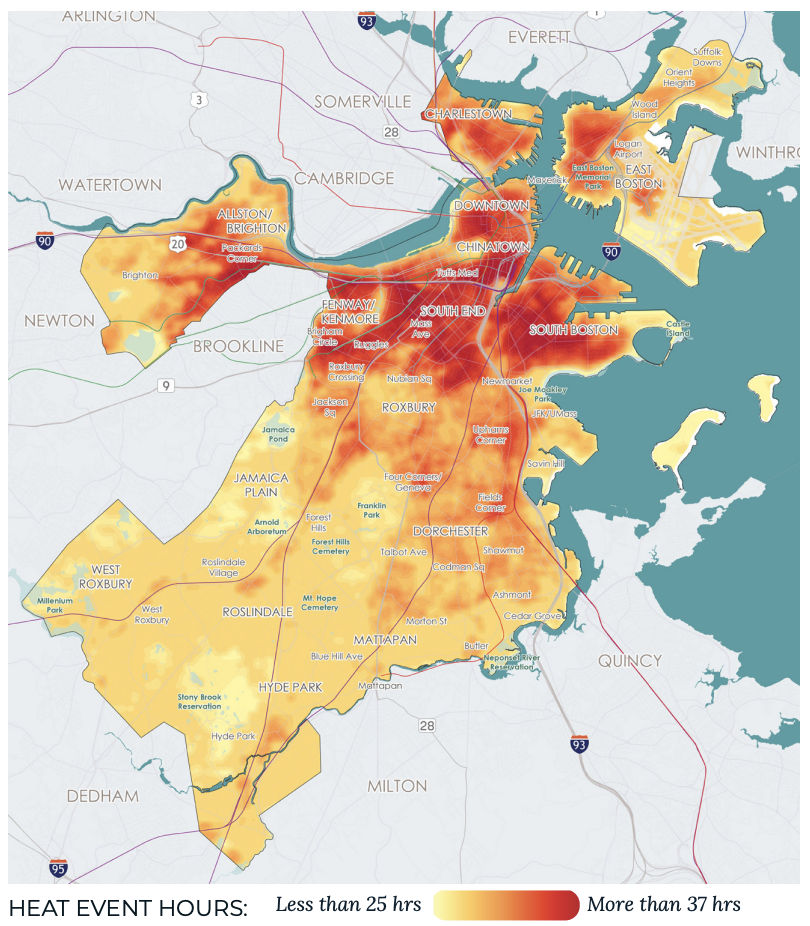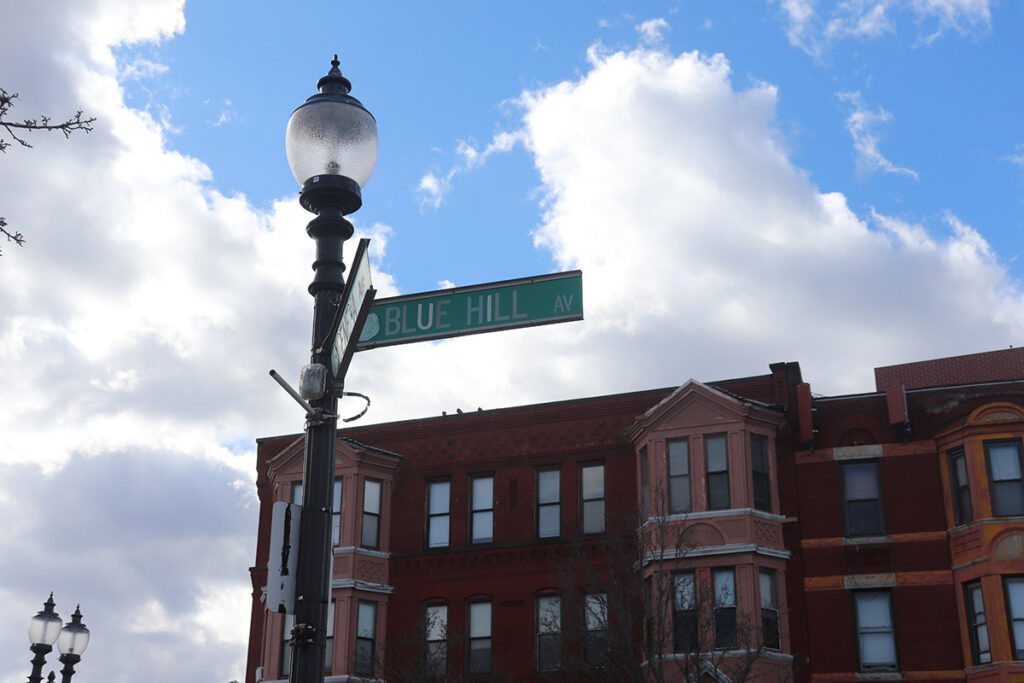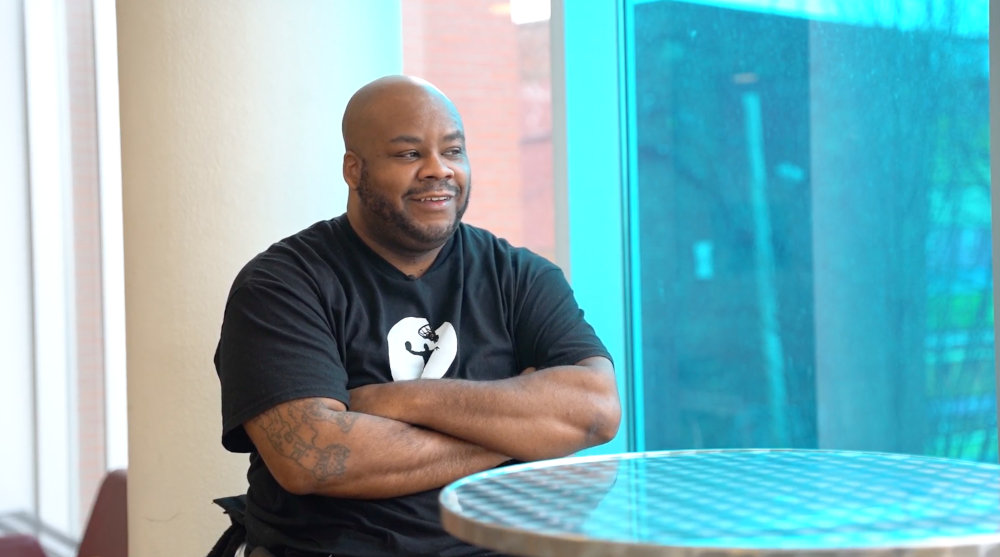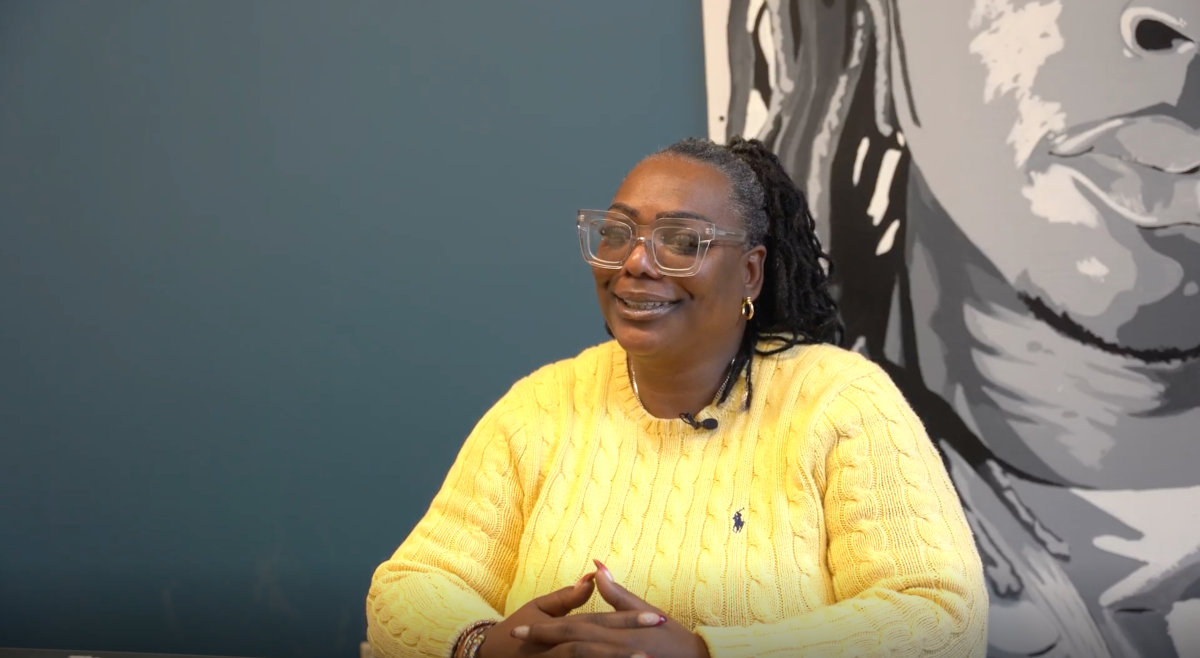Extreme heat, flooding and lack of tree coverage have serious effects on the well-being of community members
Katarina Schmeiszer, Grace Sawin and Ada Spiwak
Nicole Flynt and Al Peeples talk about how enviornmental issues affect the community.
“Green” is not the word that comes to mind when walking down the Blue Hill Avenue corridor in lower Roxbury. Children play in parks with patchy grass and bathe in pools of rain and groundwater on a flooded street on a hot day in summer. This sea of tar and bare concrete isn’t a consequence of weather; it is a testament to the chronic lack of greenery in traditionally low-income and minority neighborhoods throughout Boston.
Environmental issues along Blue Hill Avenue
The area around Blue Hill Avenue, the main artery spanning Roxbury and Dorchester — what the City of Boston describes as “Boston’s central spine” — is an urban heat island, where a high concentration of concrete and a lack of green spaces can lead to local temperatures up to 7 F higher than surrounding areas. The area is historically home to Boston’s Black and immigrant communities.

Each neighborhood is part of Boston’s urban heat island and is hotter than the surrounding areas, but areas like Downtown Boston benefit from increased tree coverage, which Roxbury and Dorchester lack. Source: City of Boston
Aljemall Peebles grew up on Blue Hill Avenue and is now a youth project director for Project RIGHT (Rebuild and Improve Grove Hall Together), a collaborative organization that is working to address issues of housing, violence and economic development in Grove Hall.. He has seen how the community has reacted to environmental stressors and is concerned about how excessive heat leads to more violence.
Peebles’ experiences have led to his role as a youth activity worker for Project RIGHT, which he joined to run the youth basketball league. Growing up, Peebles loved to play sports but had no access to organized leagues. The community has been able to expand these youth programs despite adequate resources, such as proper courts or buildings with air conditioners, being available. Last summer, during a pilot program in the new facilities, temperatures reached 95 F.
Aljemall Peebles grew up on Blue Hill Avenue and is now a youth project director for Project RIGHT (Rebuild and Improve Grove Hall Together), a collaborative organization that is working to address issues of housing, violence and economic development in Grove Hall.. He has seen how the community has reacted to environmental stressors and is concerned about how excessive heat leads to more violence.
Peebles’ experiences have led to his role as a youth activity worker for Project RIGHT, which he joined to run the youth basketball league. Growing up, Peebles loved to play sports but had no access to organized leagues. . The community has been able to expand these youth programs despite adequate resources, such as proper courts or buildings with air conditioners, being available. Last summer, during a pilot program in the new facilities, temperatures reached 95 F.

Heat islands not only exacerbate the demands for technologies that emit large amounts of climate-warming carbon, like air conditioning, but they can also worsen air quality, contributing to respiratory issues and other pulmonary health effects. In 2023, according to data from the Boston Public Health Asthma Report Roxbury and Dorchester ranked the second highest in asthma rates.
In Boston, areas such as Roxbury, the South End and Dorchester, as well as Allston and Brighton, have elevated surface temperatures.
Community Impact
Residents of Blue Hill Avenue feel these impacts every day, and as the warmer seasons approach, community members brace for extreme heat.
According to a survey conducted by the city of Boston, the burden of heat exposure in residential homes “falls disproportionately on Black and Latinx communities.” Residents often feel too hot to stay home during warmer days, leading them to find refuge in community centers.

Al Peeples, youth program director for Project RIGHT, is working to address violence in his neighborhood, which is exacerbated by the disproportionately high heat Blue Hill Avenue experiences.
“We’re coming up on the summer, you will see how hot it is around here. And there’s only one cooling center… When you have a lack of cooling centers and nowhere for teenagers to go that creates a problem,” said Peeples.
Other than feeling excessive heat, residents surrounding Blue Hill Avenue also face adverse health effects because of increased dust and particulate matter in the air from pollution and mold from flooding.
“There are health implications of these issues. For example, asthma due to mold from flooding or due to air pollution,” said Moira Zellner, professor of public policy and urban affairs at Northeastern University and co-project lead of Project Common SENSES, a collaboration between Northeastern University, the communities in Roxbury and Dorchester and the City of Boston.
Project Common Senses supports environmental justice action for the neighborhoods along Blue Hill Ave. by deploying environmental sensors to make more informed decisions about green infrastructure and working with community groups like Project RIGHT. At the time of publication, Project RIGHT has lost funding due to the Trump administration policies on diversity, equity and inclusion and National Science Foundation grant cuts.
Nicole Flynt, Grove Hall Community Coordinator for Project RIGHT and Common SENSES, said that increased construction in the area also leads to environmental is sues. The construction causes noise as well as air pollution. According to the Occupational Safety and Health Administration, or OSHA, excessive dust created by construction must be maintained through filters or water hoses to prevent spreading. OSHA also states that construction dust, including crystalline silica, can cause deadly forms of lung cancer if inhaled. Flynt said these controls are not in place in her neighborhood.
“This soot and dirt residue, or whatever residue you want to call it, on the houses, on the cars. On the sidewalks. It’s all over, and if it’s on your car, on your house, on your sidewalk, it’s in your mouth and your lungs,” Flynt said.
Sensors along Blue Hill Avenue show high levels of pollutants
CommonSENSES’ map provides real-time levels of particulate matter (PM) recorded by sensors in the area.
CommonSENSES’ map provides real-time levels of particulate matter (PM) recorded by sensors in the area.
Looking Ahead
Heat islands are more intense in areas with less tree coverage. While these areas already had more tree coverage than the downtown areas, minimal efforts have been made to increase tree coverage here to help combat intense heat.
You said:
This is Boston, divided up by neighborhood and where Blue Hill Avenue runs in Boston. Blue Hill Avenue runs through Roxbury, Dorchester and Mattapan to the edges of the city.
Here are the asthma emergency department visits among 5 to 17 year olds in Boston per 10,000 residents age 5-17. Note: Dorchester is the average of two rates. From the most recent City of Boston Heat Resilliance Plan (2023), ED visit data from 2014-2015
Here is the change in tree coverage by Boston neighborhoods. In Roxbury and Dorchester, where Blue Hill Ave runs, tree coverage has either decreased (lightest green at -0.9) or remained constant (slightly darker at 0.0).
Residents said the biggest factor that made their neighborhood hotter than other places in Boston, the most common answer was “very few trees, according to a streets and corridors survey conducted by the city of Boston,
Mockup of what an area along Blue Hill Avenue could look like with more trees. This lot is located at 639 Warren Street which currently has a plan in development to add a large residential and commercial building.
According to the Environmental Protection Agency, areas with more tree coverage can be up to 7 F cooler than areas without.
Community Action
Groups like Project RIGHT are working to achieve their goals through community engagement and activism.
“It’s an uphill battle, but what’s so amazing is the people. The community members that are constant. Constant, and steadfast, and resilient…they are here for the long run,” said Flynt.
Project RIGHT hopes to mitigate violence through community and youth involvement and create spaces that promote community building and currently has ongoing programs focusing on arts, civic engagement, public safety, sports, substance use, trauma and youth development.

Nicole Flynt is the Grove Hall Community Leader for both Project RIGHT and Project Common SENSES, two groups working to combat the environmental injustice on Blue Hill Avenue.
“When it comes to dense or moderate to low income, or even I dare say Black and brown neighborhoods…we’re overlooked a lot,” said Flynt. “And that’s not right at all. So we have to make a change.”
For community members like Flynt, these changes would improve their quality of life for generations to come.
“I have a grandson, he is 4 years old, I want him to live a good life. I want him to run in some grass, and feel the trees and breathe fresh air without having to leave the neighborhood. We always have to leave, why do we have to leave?” said Flynt.



